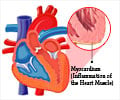The cells that contribute to the heart muscle accumulate novel genetic mutations over time — while losing the ability to repair them.

Cataloguing Mutations in the Aging Heart
Using sophisticated bioinformatics techniques and analyses, the team compared the number of non-inherited mutations, known as somatic mutations, in cells of different ages and also looked for mutational patterns or “signatures” that might illuminate the mechanisms of heart disease.‘Heart cells also accumulated mutations at rate three times faster than neurons, another cell type that doesn’t divide.’





“This is the first time somatic mutations have been looked at in the human heart at the single-cell level,” says Choudhury, who is co-first author on the paper with Huang. The older the cells were, the more single “letter” changes (known as single-nucleotide variants) they had in their DNA. The pattern of these mutations suggested that many of them were caused by oxidative damage.
“Because the heart is always pumping, it uses a lot of energy,” elaborates Ming Hui Chen, MD, MMSc, a cardiologist in the Division of Genetics and Genomics and Department of Cardiology at Boston Children’s. “This energy production creates chemical byproducts known as reactive oxygen species or ROS. When levels of ROS get too high, they can damage DNA.”
Adding insult to injury, mutations also affected pathways that cells normally use to repair DNA damage. “The mechanisms that repair DNA damage are also impacted by age,” says Choudhury. “These may be overwhelmed if there is enough oxidative damage.”
The technically difficult study drew on single-cell whole genome sequencing and bioinformatics techniques pioneered in the laboratory of Christopher Walsh, MD, PhD, at Boston Children’s, of which Choudhury and Huang are members. The Walsh lab recently used the methods to document the accumulation of mutations in neurons in people with Alzheimer’s disease.
Advertisement
In addition to DNA repair pathways, mutations affected genes involved in the cytoskeleton, the scaffolding that gives cells their structure, and other basic cell functions.
Advertisement
More to Explore
The researchers note that their study only looked for single-nucleotide variants and did not investigate other types of mutations, such as DNA insertions or deletions. Also, because they looked at healthy heart cells, they can’t establish that the mutations are involved in heart disease. In the future, they plan to look at mutations in tissue from patients with different cardiovascular diseases.Chen, who studies how chest radiation and chemotherapy for cancer affects cardiac health, plans to collect data from cancer patients who have heart disease.
“We also want to look at different cell types in the heart,” adds Choudhury. “We’ve only touched the tip of the iceberg.”
Source-Eurekalert















